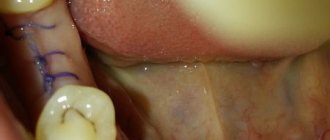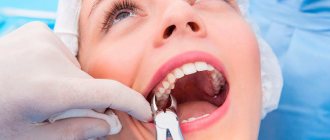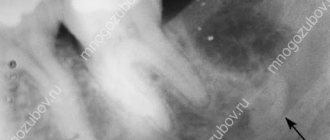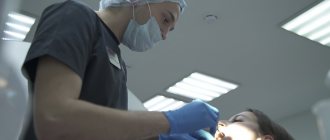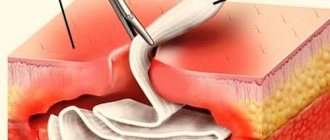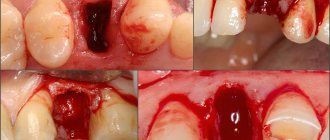Author of the article:
Soldatova Lyudmila Nikolaevna
Candidate of Medical Sciences, Professor of the Department of Clinical Dentistry of the St. Petersburg Medical and Social Institute, Chief Physician of the Alfa-Dent Dental Clinic, St. Petersburg
Let's figure out how to determine that gum inflammation has begun after tooth extraction, how to quickly get rid of it and prevent its occurrence.
Signs of normal wound healing
After a tooth is removed, a hole is formed in the empty area in which a natural blood clot accumulates. It is very important to monitor it closely. This substance must not be removed, scrubbed, washed or dissolved. A blood clot is the most reliable protection of a wound from infection and inflammation.
Gum restoration begins 3-4 days after tooth extraction. If the operation was traumatic, the healing process lasts 5-7 days. After removal of wisdom teeth (“eights”), the healing process can exceed 10 days. The back teeth are the most “complex”, as they have many canals, so after their removal the risk of gum inflammation is especially high.
Within 5-7 days after tooth extraction, a white film appears at the bottom of the empty socket. This film is an absolutely normal reaction of the body, as protective fibrin covers the wound from “attacks” of pathogenic organisms. Just like a blood clot, the film should never be processed.
The speed of healing of the hole depends on a number of factors:
- depth of the operation performed;
- localization of the focus of the operation;
- associated dental problems;
- the state of immunity and other characteristics of the patient’s body.
If the gums are swollen and begin to bleed within half an hour to an hour after tooth extraction, this is normal. However, if the inflammation does not subside within a few hours, be sure to contact your surgeon.
Gum care after tooth extraction
16.11.2019
There are many nuances in the rules for caring for a hole after tooth extraction, but everyone can guess their main goals - to prevent infection from getting into the wound and to ensure that the healing process proceeds quickly. And although the majority of dental surgeons give their patients recommendations after extraction (about what can and cannot be done), many patients forget the rules or neglect them. But such an attitude can cause many health problems. In today's material we will talk about exactly what to do after tooth extraction - how to properly care for the hole, how long it takes to heal, what complications there are after improper care. Read about it in today's article.
How does normal healing of a hole occur after removal?
Tooth extraction (or extraction, in scientific terms) is a small, but still a surgical operation. You need to take it seriously and carefully remember what the dentist says after the procedure. Usually the doctor does not talk about what the hole looks like after removal. Therefore, some patients begin to worry about the appearance of the wound when they open their mouth and look in the mirror. Let's look at what it should look like normally and how it heals properly. The photo below clearly shows a normal socket a few days after extraction. It doesn't look pretty, but it's a fact.
How does the normal process of overgrowing a hole occur? After tooth extraction, a deep wound remains on the jaw. There is nothing scary about this, because the roots that were removed from the jaw could have been the same length as the crown - that’s why the wound is so deep. It also bleeds for some time. This occurs due to the fact that microscopic vessels have ruptured. After a few hours, the blood begins to “coagulate” and fill the wound, i.e. A blood clot begins to form. Bleeding should stop within 20-30 minutes after extraction. But depending on the physiological characteristics of each person, this process can take 3-4 hours.
Important! After removal, the doctor will apply a sterile bandage to the wound - you need to close your jaws tightly. This will slow down the process a little. The procedure can be repeated at home. But if bleeding persists for more than 4 hours after surgery, you need to go to the clinic. Another probable cause of bleeding may lie in high blood pressure - it must be measured. If the readings are higher than standard, then take blood pressure medication.
The blood clot (and in the first 2 days it looks like a dark burgundy mass that fills the wound by about 2/3) has a very important function - it protects damaged tissues and bones from microbes and food particles. In the first 24 hours, you should under no circumstances touch the clot - neither with your tongue, nor with a toothbrush, and even more so, you should not move it or remove it from its place. This way, an infection will get into the wound, which can lead to complications (we’ll look at them a little later).
The appearance of the clot changes by 2-4 days, because a thin white coating grows on top of it. This is not pus, as many might think, but new epithelial tissue (fibrin protein). It will gradually replace the clot - thus the edges of the wound will grow together. Usually, after 2-3 weeks, the wound above the site of the extracted tooth heals and takes on its usual pink color - this means that the healing process of the hole was successful. The photo shows what the hole should look like after overgrowing.
Stages of healing and recovery
The entire wound healing process can be divided into several stages. Moreover, not only soft tissues are restored. Bone will also form under the gum - it will fill the place where the roots were located. This process is not visible to the eye and is not felt at all.
Let's take a closer look at the stages of healing:
- stop bleeding: blood should stop oozing within 2-4 hours. On the first day you can detect very little blood in the saliva - this is normal, this is how the ichor is released,
- clot formation: it should appear within 2 to 24 hours after extraction. At this time, you begin to feel pain in the jaw and swelling, headache, there may be a slight temperature (up to 37.5⁰C), fatigue, pain when opening the mouth and swallowing. All of these symptoms are completely normal at this stage.
- the appearance of a thin layer of young epithelium over the clot: occurs 2-4 days after extraction. Normally, it may have a white or gray color (the plaque will be clearly visible to you). Also at this stage, your health improves, swelling subsides slightly, the temperature drops to the usual 36.6⁰C,
- the new connective tissue grows strongly, and the clot decreases towards the center: such changes are visible on days 5-8. Additionally, you can notice that it is almost no longer painful to chew on the sore side, the swelling has completely subsided. During this period, the doctor removes stitches, if they were applied,
- the wound is completely covered with granulation tissue: the gums take on a natural appearance and color - this happens after 2-3 weeks,
- bone tissue growth: begins 3-4 weeks after tooth extraction and lasts 3-6 months.
It is important to know! If the extraction was carried out against the background of existing oral problems (periodontitis or periodontal disease, for example), then the healing and recovery time will increase by about 1-2 weeks. The rehabilitation period may also increase if socket care measures are not followed.
Feelings and manifestations after removal: norm and pathology
It has already been said that tooth extraction is an operation. Accordingly, it will bring the patient not only relief - that the diseased tooth has finally been removed, but also pain - while the damaged tissues and blood vessels heal. Let's figure out what symptoms may occur during normal healing, and with which you need to urgently rush to the clinic.
Let's look at the symptoms of normal healing and threatening conditions.
| Symptom | Norm | Threat |
| Tissue swelling, swelling of the cheeks, soreness and redness of the gums | Gradually decrease over 2-3 days. By day 4 they should completely disappear. There may be cases when the pain gradually goes away within 7-10 days - if a complex removal was performed | Each condition individually or all together does not go away by day 4 and does not become weaker. They can gain strength every day. Need to see a dentist urgently! |
| Hitting the hole | White or slightly gray tint on day 2-3 | Dark gray, yellow and green colors, coupled with pain and redness, signal complications - run to the doctor! |
| Body temperature, fever, chills | On 1-2 days the temperature may rise to 37.5-37.7⁰С | It rises above 38⁰C and does not subside for a long time. Chills and fever appear |
| Difficulty opening your mouth | The first 1-3 days. Improvements are being seen every day. With complex extraction of the lower “eights”, difficulties persist for up to 7-10 days | The problem persists for 4 days or longer |
| Bad breath and taste in the mouth | Maybe in 1 day if the doctor applied a tampon with medicine | A putrid odor appears on day 2-3 - a sign of inflammation. Need medical help |
| Numbness | It is retained for the first day after removal, because anesthesia is in effect | There is more than a day left. You should see a doctor, there may be nerve damage |
Important! With all the threatening symptoms, you cannot hesitate, because... they talk about serious complications - inflammation, remains of root fragments in the socket, infection of the jaw bones. There is only one solution - urgently see a doctor.
What affects the rate of tissue healing
- poor oral hygiene: risk of infection during tooth extraction,
- injuries in the mouth: bruises and injuries pose a risk of prolonged healing,
- inflammation of the gums and throat: gingivitis, periodontitis, sore throat, pharyngitis - these are additional foci of infection,
- there are fragments of roots left in the wound: this can happen if the dental surgeon is poorly qualified. They will need to be removed at the clinic, where the doctor will wash the wound with an antiseptic,
- poor blood clotting and diabetes: medications for diabetes thin the blood, preventing the formation of a blood clot in the wound,
- high level of estrogen: tooth extraction in women has its own characteristics - the maximum level of the estrogen hormone rises on days 11-14 of the cycle, and a jump is also observed during menstruation. Increased estrogen prolongs bleeding time - so dentists recommend refraining from surgery on such days.
It is important to know! In the last 2 groups of patients there is a risk of complications. Of course, if a tooth hurts very badly and needs to be removed urgently, the doctor will not refuse, because life may depend on it. However, you will have to strictly follow all care recommendations. And for diabetics, have their treatment adjusted by an endocrinologist.
Correct behavior after deletion: what you can do
Rules for caring for a hole after tooth extraction were created specifically to speed up the period of recovery and healing, and quickly return the patient to normal life. Let's figure out what can and should be done after extraction, and what is strictly contraindicated.
- You can remove the bandage after 20-30 minutes: the surgeon applies a sterile gauze swab to the wound. It is necessary to compress ruptured vessels and capillaries to stop bleeding,
- do not touch the hole and clot: even if you are very interested in how the place of the extracted tooth feels, you should not touch it. If the protective barrier is damaged, inflammation may begin,
- do not drink or eat for 2-3 hours: so as not to blur the forming clot, and so that pieces of food do not get into the wound - they can begin to rot,
- mouth baths for 2-3 days - just keep the solution in your mouth on the sore side. Start rinsing only with the permission of the dentist, usually it is allowed to do this for 3-4 days,
- exclude physical activity for 2-4 days: you should also avoid flying, going to the bathhouse and sauna, and avoid overcooling. All these actions affect the narrowing and expansion of the walls of blood vessels, which is fraught with bleeding and inflammation,
- you can take a pill for pain: the effect of the injection given before the operation ends after 2-6 hours, and the injury will begin to cause pain. You don’t need to endure severe pain, but if it doesn’t hurt too much, then there is no need for a pill.
Incorrect actions after deletion: what not to do
- drink through a straw, suck food out of a spoon and from tubes: because of this, the clot may be damaged or even pulled out of its place,
- play sports, lift weights,
- touch the clot with your tongue or try to remove it,
- rinse your mouth in the first 24 hours: too vigorous movements can dislodge a blood clot,
- eat hot food, chew on the injured side for 4-5 days,
- smoking and drinking alcohol: it is necessary to give up bad habits the day before extraction and until the wound heals. The process of smoking creates a vacuum (the clot can be pulled out of the hole) and alcohol increases blood pressure (the bleeding will not stop for a long time).
Important! Mouth rinses are strictly prohibited! You should also not eat on the operated side - all this can lead to an inflammatory process. These are the two basic and most important rules that must be followed.
How to care for a socket for quick healing
Do I need to take care of the wound? How can I treat it to make it heal faster? For speedy recovery and relief of inflammation, the dentist may prescribe:
- antiseptic gels: “Cholisal”, “Solcoseryl Dental”,
- antibiotic gel: Metrogyl Denta,
- antihistamines,
- antibiotics: tablet forms of amoxicillin or metronidazole,
- rinsing only on days 3-4: with a soda solution or Rotokan. Let us remind you that for the first 3-4 days, and sometimes even a week, only keep the products in the form of oral baths.
When should stitches be removed after surgery?
Sometimes patients ask - why didn’t they sew up my gums? After the operation, the surgeon evaluates the condition of the soft tissues and the rate of bleeding cessation. If the area of the wound is small and the bleeding has stopped, then the prerequisites for favorable healing have been created. You can do without seams. And if a very large element, or the lower “sage”, was removed (the dentist had to make incisions on the gum or cheek), then the edges of the wound are stitched. This way there is less risk of infection during the recovery period.
Today, it is rarely necessary to remove stitches - as a rule, doctors use threads that dissolve on their own. This happens in about 5-10 days. If any pieces remain, you can visit a doctor - he will remove them. But please don’t do it yourself, especially with dirty hands!
How to stop bleeding from a wound
Some patients have noticed that after extraction something is placed in their socket and left there. This is not a sterile bandage, as many might think (although it is also sometimes used if removal is simple). In case of prolonged bleeding, the dentist can insert a hemostatic sponge into the wound - it will absorb excess blood. Sometimes the surgeon even puts on 2 layers - the bottom one remains in the wound for several days (it will act as a clot), and the doctor will change the top layer. Therefore, such patients will require daily clinic visits.
“This summer I faced a difficult removal: not even an “eight”, but a “six”. The roots were twisted, the doctor sawed something out there, and then put, as he said, a special sponge. And he put some more stitches. This scared me - I didn’t want to cut my gum again to remove the sponge. And it turned out that it would dissolve on its own inside, and the stitches would also dissolve. The wound healed very quickly!”
Kristina L.,
How to relieve pain and swelling
In addition to recommendations for caring for the sore spot, the dentist may recommend procedures and medications for pain and swelling. You can get rid of severe pain both with the help of medications (Ibuprofen, Ketorol) and with the help of good emotions - watching your favorite movie or reading an exciting book.
Antihistamines (for allergies) help with swelling. "Suprastin" or "Zodak", for example. You can also apply cold to your cheek for the first 1-3 days. But without fanaticism, so that there is no frostbite. It is strictly forbidden to apply heat! Otherwise, inflammation will develop.
Possible complications and dangers of improper care
What dangers can await the patient due to illiterate care and other reasons? What complications require urgent treatment in dentistry?
- dry socket or alveolitis: this is an inflammation of the tissues of the socket,
- abscess: a complication of alveolitis, the infection enters the bone, suppuration appears. For treatment, the dentist can use curettage - scraping pus from the hole,
- phlegmon: another complication of alveolitis, very serious and threatening - purulent contents spread into the soft tissues of the cheek or neck. Severe swelling appears,
- cyst: sometimes purulent sacs - cysts - appear at the tops of the roots. If an X-ray is not taken before removal, the doctor may not see dangerous lesions. Then, even with a normally formed clot, inflammation is possible. It is treated with either curettage or laser.
All patients should remember that normal rehabilitation after removal depends on proper and competent care of the hole. Therefore, carefully follow all recommendations and instructions. Be healthy!
Category: Tooth extraction Published by Mister stomatolog
Types of inflammation
The most common types of inflammation that occur after tooth extraction are:
- Alveolitis is an inflammation of the walls of the empty socket of an extracted tooth. The patient suffers from swelling, redness, and “tugging” pain. Weakness, malaise appear, and body temperature rises.
- Gingivitis is inflammation caused by tooth extraction. The tissues turn red, begin to swell and bleed.
- Periostitis is an inflammation of the jaw bone (periosteum). The disease is characterized by severe toothache, swelling of the gums, gumboil, and distortion of the facial contour. Pathological mobility of the tooth appears, lymph nodes are palpated in the face and neck.
- Periodontitis is inflammation of the periodontium, the area around the root of the tooth. The disease is characterized by aching or sharp pain in the tooth, which intensifies when biting. Without treatment, the pain gradually turns into throbbing, tearing pain. The patient complains of severe weakness, fever, and sleep disturbances.
- Trauma to the gums from dental fragments. With mechanical damage to tissues, swelling, redness appear, and spontaneous pain begins, intensifying when touched. If the injury persists for a long time, a dark pressure ulcer with purulent and serous discharge may form at the site of injury.
Symptoms of inflammation
Inflammation of the gums after tooth extraction is indicated by the following symptoms:
- Bleeding from the wound. Even cold compresses do not stop the bleeding.
- Redness, swelling, pain in the gums that does not subside within 5-7 days after extraction.
- Throbbing sharp pain in the empty socket.
- Unpleasant putrid odor from the mouth.
- Discharge of pus from the wound, the resulting fibrous film becomes green.
- Numbness of the jaw, cheeks.
Treatment of inflammation
Treatment of gum inflammation after tooth extraction depends on the disease that arose during the operation. If a problem is suspected, the patient is advised to consult a doctor. An experienced dentist will determine the nature of the inflammation and prescribe proper treatment.
- In case of alveolitis, tissue curettage is performed, all contents are scraped out of the hole, and the tissues are sanitized. The doctor places a swab with an antiseptic on the wound.
- Periostitis is usually treated surgically. The doctor opens the rotting lesions and carries out medical treatment using anti-inflammatory, painkillers and antibiotics.
- Gingivitis requires the removal of tartar, normalization of oral hygiene and gum care using special rinses.
- For periodontitis, complex treatment is carried out using antibiotics, antiseptics, as well as anti-inflammatory and painkillers.
- Broken tooth fragments are removed by a surgeon; rinses, applications, and baths with antiseptics can be used to relieve inflammation.
Sometimes, for inflammation of the gums after tooth extraction, the patient is prescribed physiotherapeutic procedures, for example, exposure to a helium-neon laser, a course of fluctuarization.
With proper treatment of gum inflammation after tooth extraction, the socket is restored in about 10 days, and the outbreak itself disappears within two weeks.
Indications for gum surgery
Correction of the gingival margin - cosmetic tasks
For cosmetic purposes
Gingivoplasty is performed, for example, in the following cases:
- if the gingival contour is uneven, it is lower in some teeth, higher in others. The doctor will determine the optimal level and align the edge with it;
- if the upper gum in the smile area is too short. In such cases, extension is required;
- if the gum margin covers part of the dental tissue, causing the teeth to appear smaller (the so-called shark smile), or protrudes too low under the upper lip (gummy smile). The specialist will remove “excess” tissue.
Cosmetic surgery is indicated if the features of a smile cause significant psychological discomfort to the patient. Plastic surgery will help correct imperfections or get rid of them altogether.
First aid
If after tooth extraction there is mild inflammation and there is no suppuration, it can be removed at home and prevent the spread of discomfort.
- For 30 minutes after tooth extraction, do not remove the antiseptic tampon placed in the hole.
- Do not eat for 2 hours after removal.
- If there is bleeding after tooth extraction, apply a cold compress, such as an ice cube, to the gum.
If a doctor prescribes rinses for the treatment of inflamed gums, they should be done as carefully as possible. It is important not to wash the protective clot out of the hole. On the first day after surgery, you should avoid rinsing, and on the second day, use antiseptics and herbal decoctions.
During the healing period, it is also recommended to avoid food and drinks that are too cold or too hot, and never touch the socket with your fingers, toothpicks or other foreign objects.
A reliable rinse that will help eliminate gum inflammation is the ASEPTA ACTIVE mouth rinse. This unique two-component rinse with a combination of chlorhexidine + benzidamine has antimicrobial, anti-inflammatory and analgesic effects and provides an immediate anesthetic effect.
Contraindications for surgery
Gum grafting is considered a minor surgical procedure, however, it has a number of contraindications. In particular, gingivoplasty is not performed if the patient:
- blood diseases, especially bleeding disorders;
- uncompensated diabetes mellitus;
- immune diseases in which such operations are prohibited;
- acute respiratory, inflammatory, infectious, etc. disease (temporary contraindication).
Also, before surgery, as a rule, it is recommended to carry out sanitation of the oral cavity, if necessary, to clean the gum pockets and get rid of tartar. This is necessary so that there are no pockets of infection left in the mouth, which can cause postoperative complications.
Folk remedies
Let's look at useful rinse recipes that are used to treat gingivitis and alveolitis after tooth extraction.
One tablespoon of dry crushed chamomile (sage, calendula) should be steamed with 250 ml of boiling water. The mixture should be left for an hour, wrapped in a towel, then filtered and used for rinsing. It is recommended to rinse your mouth every 2-3 hours.
The following healing recipes will help relieve inflammation and relieve discomfort:
- Mix 20 drops each of tea tree oil, cloves and liquid vitamins A and E, add a pinch of cayenne pepper. Moisten a cotton swab with the resulting medicine and apply it to the painful area.
- Wet baking soda with water to form a paste and apply it to the inflamed area.
ASEPTA gel with propolis will help you quickly cope with gum inflammation. This unique product containing the waste product of bees relieves inflammation of the gums by 31%, has anti-inflammatory, antimicrobial effects against gram-positive bacteria, as well as antipruritic and analgesic effects (reduces the pain of affected tissues), accelerates the process of regeneration and epithelization of wound surfaces, stimulates metabolic processes.
We hope that our recommendations for the treatment of gum inflammation after tooth extraction will be for informational purposes only. Treat yourself carefully and remember: at the first symptoms - acute pain in the gums, sudden changes in temperature, severe swelling of the gums, discharge of purulent exudate - consult a doctor as soon as possible. A lesion can be disastrous, so take care of yourself after surgery.
Sources:
- Clinical and laboratory assessment of the influence of domestic therapeutic and prophylactic toothpaste based on plant extracts on the condition of the oral cavity in patients with simple marginal gingivitis. Doctor of Medical Sciences, Professor Elovikova T.M.1, Candidate of Chemical Sciences, Associate Professor Ermishina E.Yu. 2, Doctor of Technical Sciences Associate Professor Belokonova N.A. 2 Department of Therapeutic Dentistry USMU1, Department of General Chemistry USMU2
- Clinical studies of antisensitive toothpaste “Asepta Sensitive” (A.A. Leontyev, O.V. Kalinina, S.B. Ulitovsky) A.A. LEONTIEV, dentist O.V. KALININA, dentist S.B. ULITOVSKY, Doctor of Medical Sciences, Prof. Department of Therapeutic Dentistry, St. Petersburg State Medical University named after. acad. I.P. Pavlova
- Comparative clinical evaluation of the effectiveness of treatment of traumatic lesions of the oral mucosa IORDANISHVILI A.K. *,** Doctor of Medical Sciences, Professor, Professor of the Department *Department of Orthopedic Dentistry of the Federal State Budgetary Educational Institution of Higher Education “North-Western State Medical University named after. I.I. Mechnikov" of the Ministry of Health of the Russian Federation (rector - Doctor of Medical Sciences Sayganov S.A.); **Department of Maxillofacial Surgery and Surgical Dentistry of the Federal State Budgetary Military Educational Institution of Higher Education “Military Medical Academy named after S.M. Kirov" of the Ministry of Defense of the Russian Federation (chief - Corresponding Member of the Russian Academy of Sciences, Professor A.Ya. Fisun).
- The role of anti-inflammatory rinse in the treatment of periodontal diseases (L.Yu. Orekhova, A.A. Leontyev, S.B. Ulitovsky) L.Yu. OREKHOVA, Doctor of Medical Sciences, Prof., Head of Department; A.A. LEONTIEV, dentist; S.B. ULITOVSKY, Doctor of Medical Sciences, Prof. Department of Therapeutic Dentistry of St. Petersburg State Medical University named after. acad. I. P. Pavlova
- Report on clinical trials of anti-inflammatory balm for gums "Asepta" adhesive, St. Petersburg State Medical University, 2007
- Report on determining/confirming the preventive properties of commercially produced personal oral hygiene products: Asepta toothpaste used in combination with Asepta mouthwash and Asepta gum balm Head. Department of PFS Doctor of Medical Sciences Professor S.B. Ulitovsky St. Petersburg State Medical University named after Academician I.P. Pavlova. Faculty of Dentistry. Department of Preventive Dentistry.
